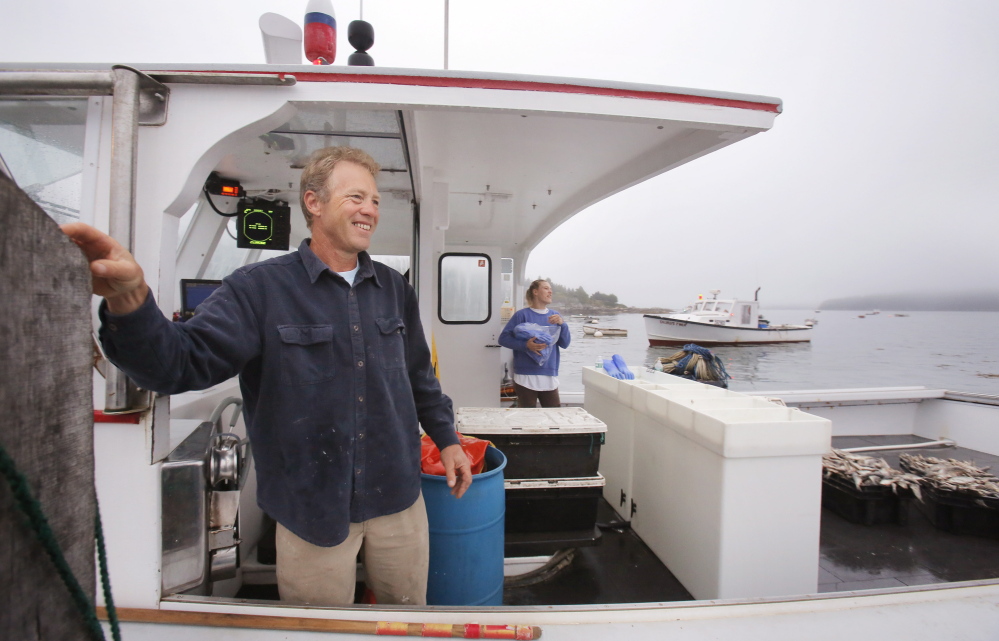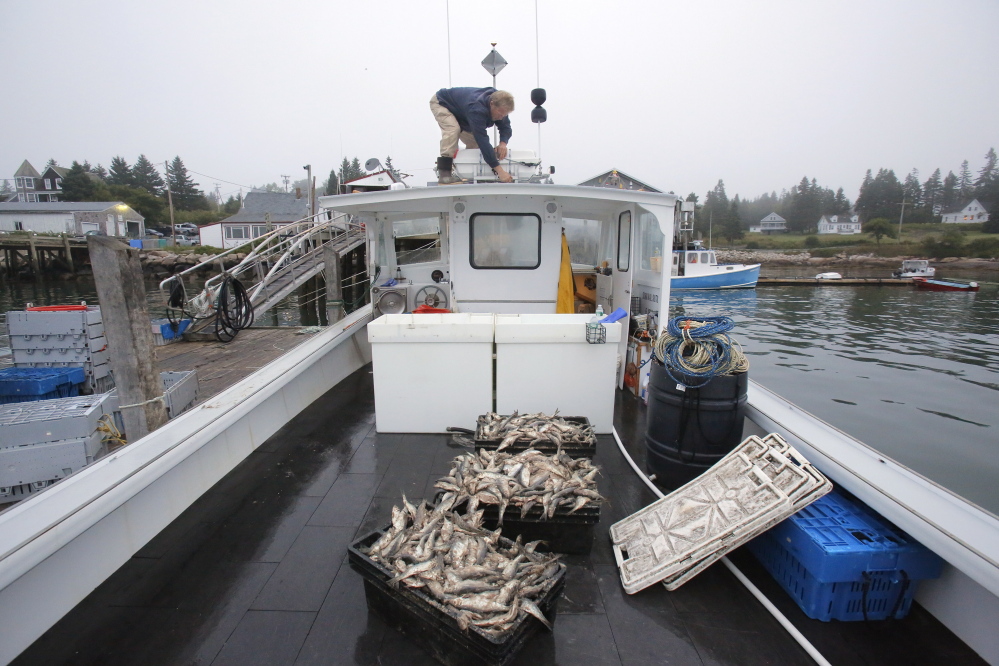Motoring into Penobscot Bay under the still-starry August sky at 5 a.m., it’s easy to understand why the lobsters beckon to Frank Gotwals. The water glistens. The quiet is encompassing, pierced only by the squawk of gulls and rumbling motors. The burnt orange sunrise washes through the sky, revealing panoramic views of a summer day tourists wait all year for.
“This is the view from my office,” said Gotwals, chairman of the board of the Maine Lobster Marketing Collaborative. “It’s one of the perks of the job.”
As Sea Song, his 38-foot wooden boat, pulls away from Stonington Lobster Co-Op wharf, Gotwals gets into a rhythm that has become etched into his muscle memory over the past 40 years.
Assisted by sternman Alyssa LaPointe, he pulls up to one of his red, white and blue buoys, and with the help of a gaff hook, brings two wire lobster traps to the side of the boat. They grab the traps and toss out crabs and seaweed. They measure lobsters with a metal gauge to make sure they’re of legal size to harvest. They flip the lobsters on their backs to check for indications that they’re female (soft swimmerets) and egg-bearing, or have been caught with eggs in the past (with V-shaped notches on the tails). Any of these must go back to the sea for breeding.
LaPointe baits the traps with herring, then pushes them back into the water. As Gotwals steers to the next buoy, she bands the claws of those that are fit to keep, then drops them in a tank.
Gotwals and LaPointe stop at the next buoy a few yards away and repeat the process.
Then they move on to the next trap and repeat it again.
And again.
And again.
They repeat it 125 times over the next nine hours, until they check 250 of the 750 traps Gotwals has in the water.
And they do this about 100 days a year.
Some traps come up empty. Other traps contain four to five lobsters destined for chowder and $30 plates of Lobster Thermidor at some of the world’s finest eateries.
“You can’t get discouraged by a bad day,” he said. “But the one thing you know is that if you don’t go out, you’re not going to catch anything.”
NEW DIRECTION
This year, lobster will play a bigger part in the time Gotwals spends off the water, as he steers the board of the collaborative, the statewide group charged with promoting the state’s $365 million catch around the globe. His charge is particularly important as Maine’s lobster industry works to regain its balance on the heels of the recession and record landings in 2012 that sank lobster prices.
“We want to make sure that lobster has a really strong place in the seafood market,” said Gotwals, 59. “That way if we have another spike in landings, the market will better be able to absorb that. And on the flip side, if the catch begins to decrease we’d have some upwards place to go on price.”
While measures like V-notching and trap limits have helped to ensure the sustainability of the fishery – and earn Maine lobster the Marine Stewardship Council certification in 2013 – lobstermen have gotten jarring reminders in recent years that those steps aren’t enough to shelter them from swings in the economy or the landings.
In 2008, when Wall Street giant Lehman Bros. collapsed, the economy contracted and prices for lobsters plummeted. As unemployment reached double digits, demand dried up for luxury items like lobster. Leisure travel ground to a halt. And bookings plunged for cruise ships and tourist destinations like Las Vegas, which both had been big markets for Maine’s lobster, said Charles Colgan, professor of public policy and management at the University of Southern Maine.
After moving steadily upward for decades, the average price for Maine lobster dropped in 2008 to $2.69 – the lowest it had been since 2002.
“For the first time, there were a lot of orphan lobsters,” Colgan said, which prompted a realization that Maine needed to better market its prized catch.
The market was pummeled again in 2012, when a surge in landings put more than 127 million pounds of lobster into the market, and prices plummeted to $2.69 per pound – nearly $2 per pound less than 2005’s record $4.63.
“The glut scared everybody,” said Gotwals. “Nobody ever thought they’d see that many lobsters, that early, all at once.”
Along with unexpected market swings, lobstermen must also contend with the more predictable increases in the cost of doing business. When Gotwals started, bait and fuel expenses might have been $30 for a day of fishing. Now they run between $175 and $250 in the summer. The oak traps that he could build for $10 when he started have given way to more durable wire traps that cost $90 apiece.
How well lobstermen contend with these pressures will be critical for Maine’s economy.
The industry that revolves around Homarus americanus is estimated to have a $1.7 billion annual impact on the state, according to the Lobster Institute at the University of Maine.
Lobster accounted for 65 percent of Maine’s total seafood catch in 2012. There are more than 5,100 licensed commercial lobstermen in Maine, and the industry employs roughly 15,000 at the peak of the season – including fishermen, processors and retailers, said Colgan.
But even beyond the numbers, many of Maine’s coastal communities are heavily dependent on lobstering.
“It’s not just the fishermen, it’s the restaurants, the boat builders and tourist industry, and so many others,” Colgan said.
Additionally, 90 percent of the nation’s lobsters are caught in Maine. The U.S. exported $512 million worth of lobster in 2012. That makes the collaborative’s role – to stoke the global appetite for lobster – even more critical.
“It’s not just a marketing campaign – campaigns come and go,” Colgan said. “But you have to have the infrastructure there to respond to the market when there are shifts in supply and demand.”
EXPERIENCED HANDS
The Maine Lobster Marketing Collaborative, formed in December, has an 11-member board made up of lobstermen, lobster dealers, members of the public and state agency representatives. Its $750,000 annual budget is funded by a surcharge on licenses issued to lobstermen, processors and dealers. The annual budget is projected to grow to $1.5 million in 2015 and $2.2 million in 2016, 2017 and 2018.
The collaborative replaced the Lobster Promotion Council, a smaller group that had been in place since 1991.
Since its formation, the collaborative has been executing a marketing strategy recommended by Futureshift, a New York-based consulting firm promoting lobster to chefs and food service professionals, in part through a partnership with the Culinary Institute of America. In July, the collaborative hired an executive director, Matt Jacobson, a former consultant and Republican candidate for governor, with more than 20 years of sales and marketing experience.
“Getting those things done has been critical,” said Gotwals.
Pat Kelliher, commissioner of the Department of Marine Resources, tapped Gotwals to lead the board, in light of the four decades he’s spent lobstering and his service in various groups, like the board of the Stonington Lobster Co-Op.
That work “has given him the expertise to engage a board comprised of different perspectives and strong opinion,” he said. “His combination of personal and professional experience has made Frank the perfect inaugural MLMC chair and the ideal leader to help the Maine lobster industry take its first steps into the new era of marketing.”
Patrice McCarron, executive director of the Maine Lobstermen’s Association, said her group was excited to see a harvester head up the collaborative board.
Beyond being a lobsterman, “he is smart, honest, experienced and cares deeply about this success of our industry as whole,” she said.
While Gotwals is in many ways at the heart of Maine’s lobster industry, he wasn’t born into Maine, or lobstering.
Gotwals, the oldest of three boys, grew up in Northampton, Massachusetts, where his father taught music and his mother was the junior choir director at Smith College. His mother’s family hailed from Stonington, and he spent summers there fishing with his great-grandfather.
“I always felt at home on the water,” he said.
He attended Eckerd College in Florida to major in marine studies, but after his first year, and a summer job raking Irish sea moss turned into work for the fall, he didn’t go back. He loved learning, but didn’t like being stuck in a classroom.
“I just couldn’t stand being inside,” he said.
Gotwals apprenticed, working as a sternman, and then started lobstering on his own in 1976.
During the offseason, he performs solo and with his acoustic group, Archipelago, and a jazz group, Isle of Jazz, around the state (he has made four CDs). That’s when he’s not with his two kids and three grandkids, or tending to the vegetable garden with his wife Donna, or caring for their three dogs.
Though Gotwals is nearing the age when many workers start thinking about retiring, after four decades of fishing he shows not a trace of weariness – nor a wrinkle or gray hair. He quickly dismisses any question about retirement.
“I like what I do. I’m not waiting around to find something I want to do more,” he said. “I could never live like that.”
Send questions/comments to the editors.




Success. Please wait for the page to reload. If the page does not reload within 5 seconds, please refresh the page.
Enter your email and password to access comments.
Hi, to comment on stories you must . This profile is in addition to your subscription and website login.
Already have a commenting profile? .
Invalid username/password.
Please check your email to confirm and complete your registration.
Only subscribers are eligible to post comments. Please subscribe or login first for digital access. Here’s why.
Use the form below to reset your password. When you've submitted your account email, we will send an email with a reset code.